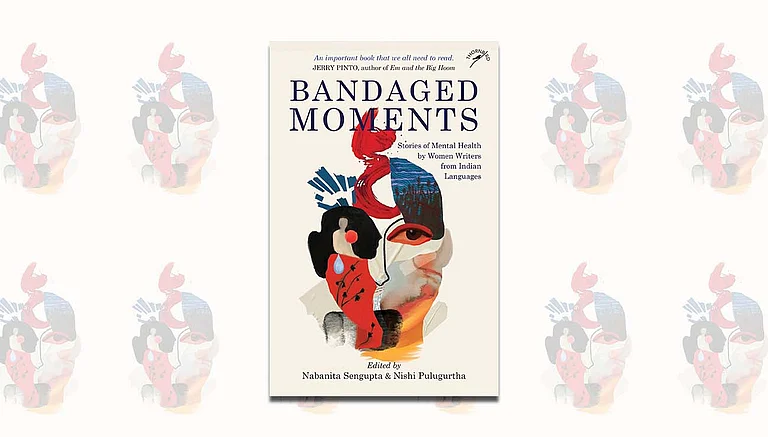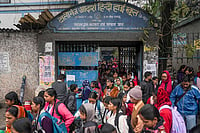
The mental hospital remains a part of cultural discourse throughout the history of India.
In 1962, amid the India-China conflict, panic gripped Tezpur after Nehru’s mistaken ‘fall of Assam’ announcement. Civil surgeon Nani Bordoloi stayed behind, freed mental hospital inmates, ran the radio station, and later earned a Padma Shri for his courage.
In 1934 at Ranchi’s Indian Mental Hospital, Major Jal Dhunjibhoy staged a mock Governor General’s visit to coax a depressed patient to eat. The hospital also kept meticulous farm records, hosted cricket matches, and organised jatras and magic shows—now largely forgotten.
The year was 1857. On the 11th of May, a straggling bunch of mutineers were coming from the not-so-distant city of Meerut, approaching the gates of the walled city of Delhi. The first ‘official’ structure they see is the mental hospital. This is outside the gates of the city, by the banks of the Yamuna, approximately where the Maulana Azad Medical College stands today. Remember that the river used to flow where the newspaper offices are located today. The significance of the date will escape nobody.
This was the first act of rebellion in India’s war of Independence—the ransacking of the mental hospital of Delhi and the ‘liberation’ of the 100-odd inmates of the hospital. History has not been kind either to the institution or its inhabitants. This act of rebellion is perhaps not celebrated as it should be, and what is completely missing is the fate of those who were liberated from the hospital. One record says “…all the patients either escaped or were set free, and were never recovered. In all probability the greater number of these perished miserably in the subsequent siege of Delhi or in the fighting before or within the walls of the city.”
This remains a defining characteristic of the mental hospital across generations.
The mental hospital remains a part of cultural discourse throughout the history of India. It may be of interest to students of literature that Saadat Hasan Manto, arguably one of the greatest of storytellers, locates the iconic tale of Toba Tek Singh in the Lahore mental hospital. The tale of the partitioning of the hospital in Manto’s story is based on a historical fact. Fiction sometimes is based on strange histories.
The story of Tezpur also needs recounting.
In 1962, during the India-China conflict, the Chinese Army reaches Bomdila, near Tezpur, and unaccountably, withdraws. In one of the major intelligence failures of modern India, Pandit Jawaharlal Nehru, unaware of this, announced the ‘fall of Assam’. This led to widespread panic and the evacuation of the city of Tezpur. One of the few civil servants who remained was the superintendent doctor of the mental hospital, Nani Bordoloi. He released all the inmates, after sending the staff to Shillong, and then commandeered the local radio station, issuing bulletins of wellbeing. This act of bravery was to earn him a Padma Shri later. The erstwhile inmates, meanwhile, roamed the deserted streets of Tezpur, understandably crediting the Chinese for their liberty, raising slogans of “China ki jai ho”. This event, resplendent with dark humour, is befitting of Manto’s imagination, but a story that is largely forgotten in public memory.
When we talk of the mental hospital, the dominant theme is that of neglect, squalor and public outrage at appalling conditions. However, in most cases, the mental hospital being such an instance, the story is not one-dimensional. This often becomes the case when public outrage enters the mix, leading to the loss of nuance and the lack of finer details.
That has, in a sense, been the fate of the mental hospital.
The fact that very difficult things happened in mental hospitals is not in doubt, but it is also a fact that the mental hospitals were places where exemplary thought and effort were invested. The story of the superintendent of the Indian Mental Hospital in Ranchi, Major Jal Dhunjibhoy, in 1934, dressing up a number of staff members as the retinue of the Governor General of Bengal—in an attempt to convince a severely depressed patient to eat—has been forgotten. The fact that in the same mental hospital, every seer of agricultural produce was documented, that there were ‘home’ and ‘away’ cricket matches in true British tradition, that ‘jatras’ and magic shows were part of the entertainment, is a facet that is forgotten. As has been the fact that Dhunjibhoy talks of “standing alongside the patient in his difficulties”—an important intervention that should find a place in medical practice even today. However, despite these forgotten exemplars, there also remain forgotten missteps.
A 2019 report on the situation in mental institutions identified a total of around 5,000 patients with severe mental illnesses who had been in institutions for more than a year. These people remained there because they had no families to go back to, or their families simply did not want them back. This highlights the fact that mental hospitals were often the only places where the disadvantaged people received support from the state. Many folks had been in these institutions for longer than they needed to be because they had no alternative.
In the push to modernisation, and the nudge towards what is called de-institutionalisation, India drastically reduced the number of mental hospital beds in the 1990s. Thus, hospitals like the National Institute of Mental Health & Neurosciences (NIMHANS) in Bengaluru, the Institute of Human Behaviour and Allied Sciences (IHBAS) in Delhi and the Lokopriya Gopinath Bordoloi Regional Institute of Mental Health (LGBRMH) in Tezpur reduced the number of patient beds from above a 1,000 each to about 400. Thus, the juggernaut of de-institutionalisation led not to reform of mental hospitals, as it should have done, but instead succeeded in shutting them down.
For the people who can afford them, private facilities continue to thrive, but the facilities for the poor have effectively drastically reduced. This led to large numbers of people being discharged, displacing those for whom the mental hospital was the only refuge. Exactly where all these discharged patients went, how they continued to fare, and more importantly, what the continuing community structural support for severe mental illness is—are difficult questions without a semblance of adequate answers. The fact that acute and short-term care of psychiatric disorders has improved tremendously is certainly not in doubt. But in this process, the fact that medicine has taken its gaze off long-term recovery continues to be a cause for concern.
In the West, this de-institutionalisation has resulted in transinstitutionalisation, with a situation bizarrely reminiscent of the past, with many more people with mental illnesses being found in jails, other penal institutions or on the streets, rather than in medical institutions. In India, where homelessness abounds in any case, many of the homeless are people with psychiatric illness.
The fact remains that mental illness is real, and there will be a section of people that will need support over longer periods of time. The decay of institutions is a risk that all societies face, and the choices we make need to be informed with the lenses of history, wisdom and continuity. At a time where the lived experiences of individuals are finding their rightful plce in societal and medical narratives, these will jostle with the non-linear histories of institutions. It is up to us to balance the two and ensure that at the end of the day, the people who need access to affordable, reliable mental healthcare are not lost in the mix.
(Views expressed are personal)
Alok Sarin is a psychiatrist working in Delhi. He is interested in history, society, psychiatry and the spaces between them
In its August 21 issue Every Day I Pray For Love, Outlook collaborated with The Banyan India to take a hard look at the community and care provided to those with mental health disorders in India. From the inmates in mental health facilities across India—Ranchi to Lucknow—to the mental health impact of conflict journalism, to the chronic stress caused by the caste system, our reporters and columnists shed light on and questioned the stigma weighing down the vulnerable communities where mental health disorders are prevalent. This copy appeared in print as 'A Difficult And Necessary Place’






























